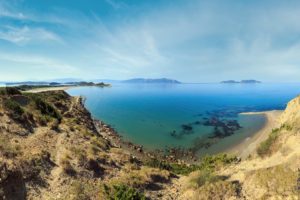In early spring on Russia’s Wrangel Island, dawn comes at 3:45 and the sky is light for 16 hours a day. My Russian colleagues and I make good progress sampling more than 20 herds of muskoxen, gathering valuable data. Yesterday, while hiking in the mountains, we again crossed polar bear tracks. As winter sea ice recedes around this Arctic island, I wonder if the bears will soon be adding muskoxen to their diet, instead of their usual fare of seals.
The contrasts between doing field research in Russia and Alaska are sharp, and nowhere more so than in the realm of safety. Here, there are no seat belts on helicopters, no shovels brought on snowmobiles (in the event we become stuck), no spare tent, bivy sack, or sleeping bag for emergencies. Rarely do our communications work. The adage I know so well — there are old biologists and there are bold biologists, but there are no old, bold biologists — is an unfamiliar one here.
Today, the winds blow, and it’s near whiteout conditions. I admire the tenacity of my coworkers. With little modern technology and minimal aerial support, they persevere. Yesterday, the temperature returned to winter with the mercury at -15 degrees F. Soon, we’ll shift camps and travel 50 miles to an unheated cabin. My Russian colleagues endure these hardships for one reason — to better understand Wrangel’s animals, their movements, and the island’s ecology.
I’ve come to Wrangel Island to join them in this research, my chief goal being to help my fellow scientists learn how to use cameras to measure the dimensions of muskoxen from afar. I’ve also come to improve scientific cooperation between Russia and the United States in Beringia, that area of northwestern Alaska and extreme northeastern Russia where two countries — and continents — are divided by the Bering Sea. No region in the world has been more affected by climate change than the Arctic, and I am hopeful that the data we gather on muskoxen and other wildlife on Wrangel Island will help science better understand how rapid warming is impacting the Russian and Northern American Arctic.
As the wind howls outside our cabin, I show a PowerPoint presentation to some of the Russian staff and everyone crowds my little computer screen. I focus on how and why we do scientific studies, my words translated by my Russian-American translator, Lizza Protas. I explain why publishing is important, so that all the time and money that go into research can be used to benefit others and the generations that come after us.
I have worked for years in Arctic Alaska, and one reason I came to Wrangel Island — 300 miles above the Arctic Circle — was to see how rapidly warming is occuring here and what kind of data exists. I was delighted to learn that a meteorological station has been operating continuously on Wrangel since 1926. My Russian colleagues gave me digital copies of their weather records, and my U.S. colleagues and I will study this important data to compare temperature trends on Wrangel with data from northwestern Alaska.
No significant climate change studies have been carried out on Wrangel Island. Dr. Alexander Gruzdev, the director of the Wrangel Island Nature Reserve, told me that he has observed no major shifts in the denning chronology of the island’s many polar bears. But large parts of the Siberian Arctic are experiencing rapid warming, with sea ice disappearing (as it is throughout the Arctic) and northern Siberia’s kettle-like lakes draining as permafrost thaws and cracks.
Five hundred miles to the southeast, across the Chukchi Sea and the Bering Strait, more than 50 muskoxen died suddenly in 2011 from being inundated by frozen slush fueled by 60 mile-per-hour winds while feeding in an inlet near Shishmaref, Alaska. Also on the Alaskan side of Beringia, the shorter snow-free season and warming temperatures are already making it tougher for my native American guides to use their snowmobiles to travel frozen rivers and shores in the pursuit of caribou, which are vital to their villages’ food supplies.
The good news is that on both the Russian and the American sides of Beringia there are opportunities. The Shared Beringia Heritage Program enlists Russian and American scientists, as well as the people of Alaska and Russia’s Chukotka Autonomous Region, to collaborate on research and citizen science to study wildlife and climate change on both sides of the Bering Sea.
This is the third of three blog posts from the field by conservation biologist Joel Berger.
Previous Posts:




